Marine lifting webbing must have the right load rating because saltwater, UV, and shock loads quickly reduce real-world strength.
Polyester marine lifting webbing typically supports about 450–3,000 kg WLL per strap, while UHMWPE marine lifting webbing typically supports about 600–6,000 kg WLL with a required safety factor of 5:1 to 7:1 between WLL and tested breaking strength.
Below, you’ll learn how materials, construction, and certification change that load rating so you can specify the correct WLL in your RFQ on the first try.
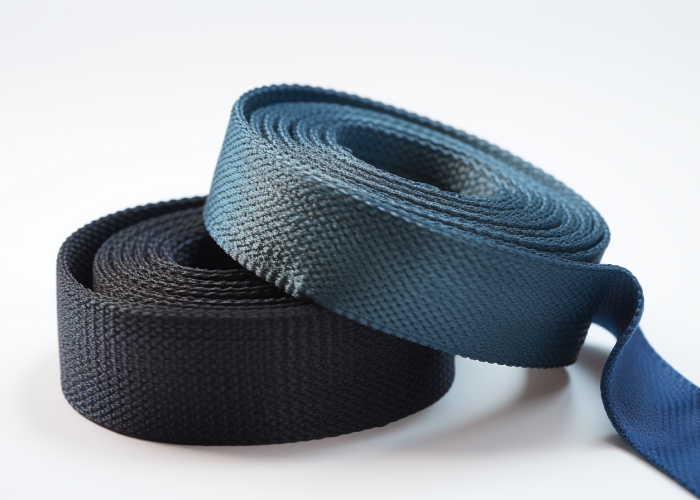

Webbing manufacturing expert with 15+ years of experience helping product developers build high-performance straps for industrial, medical, and outdoor use.
Marine lifting webbing rated at 10,000 kg breaking strength is only safe to lift about 1,400–2,000 kg WLL due to mandatory safety factors. Breaking strength comes from a single, smooth tensile test on unused material. There is no stitching, no salt, no UV damage, and no bending across hardware. It is the best-case scenario and never represents what the strap will lift offshore.
WLL, on the other hand, accounts for the actual operating reduction. The moment webbing is stitched, capacity drops because thread cuts into fibers under load, often by 30–50% unless the sewing pattern is optimized. Once the strap wraps around a shackle or hook, the bend radius concentrates stress, reducing usable width and amplifying edge wear. Then saltwater soaks in and UV slowly weakens polymer chains, removing even more capacity over time.
Where projects fail is when a supplier uses breaking strength to win the quote, then downgrades to WLL right before inspection. By that point drawings are locked, cargo schedules are fixed, and there is no room for redesign. You end up paying more to fix a problem that could have been prevented up front.
We always qualify WLL on the full assembly, including your stitch geometry and hardware radius. That ensures the load rating you design to is the one that passes inspection every year, not just day one.
Share your lifting setup anytime, and we’ll confirm the WLL that remains safe under real offshore use.
UHMWPE is the strongest marine lifting fiber at 600–6,000 kg WLL, followed by high-tenacity polyester at 450–3,000 kg WLL. UHMWPE is the strongest option by weight, and its low stretch keeps loads stable during crane lifts and wave-induced motion. It is ideal when space is tight or every kilogram matters, such as on davits or ROV deployment lines.
Polyester offers predictable elongation and excellent abrasion resistance when running across deck hardware. It is widely approved by marine inspectors because its behavior under cyclic loading is well-documented and cost-stable for wider lifting straps.
Failures enter the picture when suppliers try to save cost by swapping in nylon or polypropylene. Nylon absorbs water, increasing stretch and reducing tension retention. Polypropylene brittles in sunlight and creeps under steady load. Either material might survive one tensile test, yet lose 20–40% of capacity in just a few months at sea.
We prevent these surprises by using traceable technical-grade fibers and validating retained WLL after environmental exposure. Because offshore safety does not care about how strong the strap was when it was new—it cares how strong it is today.
If you want help choosing UHMWPE vs polyester for your lift geometry, send us the load details and we’ll guide you to the safest, most cost-reliable option.
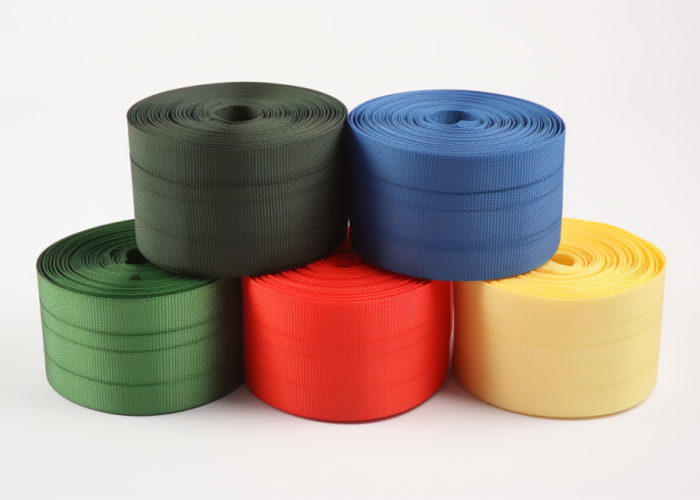
Marine lifting webbing needs UV and salt-resistant treatments to prevent a fast 20–40% drop in load capacity.Without protection, sunlight breaks down fiber strength at the molecular level. Salt crystals harden in the weave and grind against fibers every time the strap flexes. Deck friction accelerates edge wear right where load tends to concentrate.
Not all coatings are equal. TPU lamination resists abrasion and moisture but requires precise heat and pressure control to avoid peel failure. Solution-dyed fibers offer UV resistance without extra coatings, but color matching and lot consistency are critical for inspection and replacement planning. Hydrophobic sealants reduce water uptake and loading fatigue, yet they must bond without clogging the weave or stiffening the strap.
Suppliers who treat coating as a cosmetic add-on usually skip adhesion checks, leaving layers that blister, crack, or flake after limited exposure. That leads to sudden WLL drops that inspectors quickly detect—often resulting in rejected slings and downtime.
We validate coating adhesion, UV aging, and salt retention performance before sign-off, so the webbing your team installs keeps its WLL through repeated lifting cycles—not just on day one.
Tell us how long your straps remain exposed on deck, and we’ll match the coating that protects your lifting capacity season after season.
Unsure if your current strap design keeps full WLL offshore? We’ll verify strength retention with your hardware and exposure conditions.
UV and saltwater exposure typically cut marine webbing strength by 15–35% in the first year. At sea, straps constantly cycle between heavy load and slack as waves shift mass. Each flex grinds salt into the weave like micro-sandpaper, while sunlight breaks polymer chains and weakens yarns on the surface. Even coatings can crack if not properly bonded, exposing fibers right where stress is highest.
Avoid surprise rejections during annual inspection
Many suppliers quote the break strength of a fresh sample and hope retention stays high. It rarely does. When inspectors check retained WLL before a lift, failure means sudden downtime — and offshore delays can cost $20,000+ per day of idle vessel time.
We prove performance after salt-spray + UV cycling, so the WLL doesn’t disappear mid-season.
Supplier Check: Ask your current supplier:
“What is the retained WLL after 6–12 months of marine exposure?”
If they can’t answer with data, that’s a risk.
If you share your exposure conditions, we’ll confirm retention and prevent costly inspection surprises.
Loose or deforming weaves can reduce marine lifting capacity by 10–30% under hardware contact. When webbing necks down inside a shackle, the effective width shrinks and load overloads fewer fibers. Edge strain then accelerates abrasion right where stitching already reduces structural efficiency.
Prevent hidden overload at hardware pinch points
Commodity weaves twist or “rope” because they aren’t engineered for load alignment. The first sign is subtle damage during inspection — by the time you notice deformation, you’ve already lost capacity.
We design the weave based on your hardware geometry, using flat-load retention testing that generic strap makers don’t perform.
Supplier Check: Ask your current supplier:
“Do you test for width loss and weave deformation under real hardware radii?”
If the answer is “no,” real load performance is unknown.
Send a quick photo or hardware radius, and we’ll ensure your weave keeps full lifting capacity at the contact points.
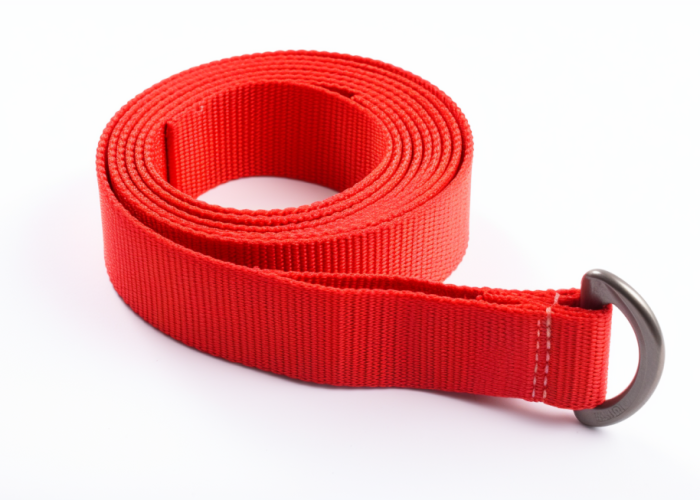
Poor stitching and tight bend radii can eliminate 30–50% of webbing’s safe lifting capacity. Even high-strength fiber becomes unreliable when bent too tightly or compressed into metal corners. Friction from rough hardware or wrong stitch program also accelerates fatigue.
Eliminate last-minute WLL downgrades caused by assembly choices
Generic stitching is quick to manufacture but fails retention tests during inspection. Bad news usually arrives late — when the lift must begin — triggering emergency retesting or strap replacement, which is far more expensive than speccing it right.
We validate the entire load path: thread material, stitch geometry, hardware radius, and tension settings. That means the strength you approve won’t collapse under real cyclic load.
Supplier Check: Ask current suppliers:
“What stitch-efficiency % do you verify during WLL testing?”
If they don’t measure it, they’re guessing.
Share your hardware and strap geometry anytime, and we’ll confirm the stitch + bend design that protects WLL through repeated marine lifts.
Marine lifting straps often require 1:1 width-to-tonnage sizing, meaning a 50 mm (2 in) wide flat web typically supports about 1 ton WLL when properly stitched and protected. Wider webbing spreads force across more fibers and reduces stress over hardware radii, while thicker constructions add abrasion life and stabilize load under dynamic vessel motion. Too narrow or too thin, and the strap will neck down under tension, concentrating load at the edges where strength is already reduced by stitching.
Avoid underspec width that fails under hardware contact
Generic suppliers may quote strength by fiber grade alone without analyzing actual contact width under load. When inspectors see roping, folding, or edge strain during proof testing, they downgrade WLL or reject the strap entirely — both scenarios delay approvals and add cost.
We size width and thickness to hardware geometry, not catalog assumptions. That protects WLL during the lift you actually perform, not the one simulated in a smooth jaw tensile test.
Send your load target and hardware measurements, and we’ll confirm the right width and thickness so WLL stays fully available on deck.
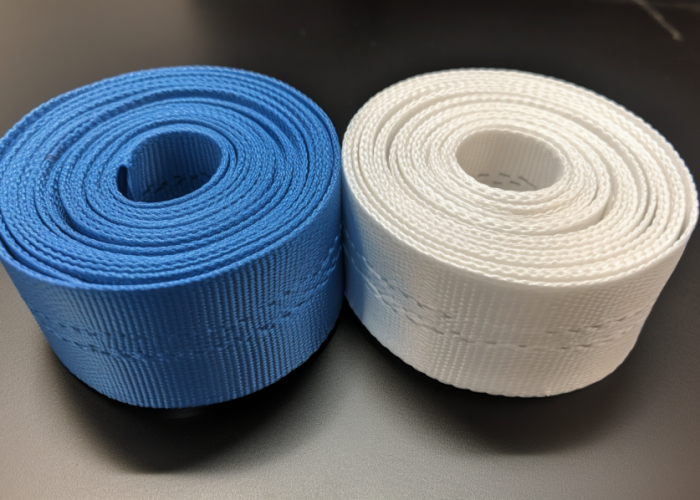
Marine lifting webbing must meet WLL and safety factor requirements defined in standards like EN 1492-1/2, DNV-GL lifting guidelines, and OSHA/ASME inspection rules when used for hoisting. These certifications ensure straps are tested with correct safety margins, traceable materials, and verified assembly-level performance — not just fiber tensile strength.
Don’t ship without certification compliance verified up front
Low-cost strap vendors may offer strong-looking samples with zero documentation. Without a traceable test record, inspectors can refuse the lift — and a port delay can cost tens of thousands per day in vessel idle charges while new certified straps are sourced.
We maintain material traceability, recorded WLL test data, and assembly-level verification aligned to your region’s marine lifting compliance requirements. That removes costly back-and-forth with safety auditors.
Tell us where your lifting equipment will be deployed, and we’ll match the certification standard your inspectors expect — with documented WLL proof included.
Marine lifting webbing must be visually inspected before every lift, with a formal recorded inspection at least every 12 months in normal service and monthly-to-quarterly in harsh salt and UV exposure. Offshore straps constantly face shock loading, seawater cycling, and deck abrasion, which create early fiber fatigue that isn’t always visible. Even when the surface looks fine, internal strength may fall below safe WLL long before year-end inspection.
Prevent mid-operation rejection that stops vessel schedules
When documented retained WLL is missing, inspectors must err on the side of caution, grounding slings until proof testing or replacements arrive. A single rejected strap can stall operations that cost tens of thousands per day in idle fees and lost time.
We provide inspection requirements tied to your exact environment so retained WLL is proactively verified, not questioned at the dock.
Share how often your slings are used and stored, and we’ll set a risk-based inspection interval that keeps lifting approvals uninterrupted.
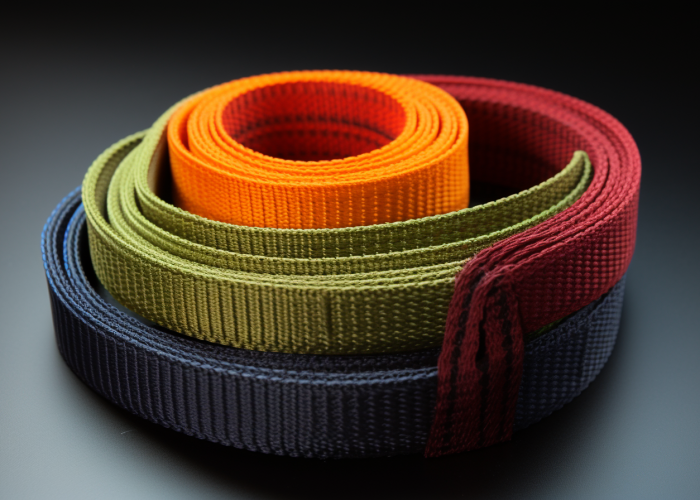
Marine lifting webbing should be specified by Working Load Limit (WLL), safety factor, certification standard, and inspection requirements—not by breaking strength alone. OSHA/ASME rules require WLL-based approval, traceable markings, and periodic inspections, but best-practice marine RFQs add the product-level details that determine if the WLL actually survives real exposure.
Avoid supplier assumptions that inflate cost later
When RFQs lack environmental exposure, hardware radius, or weave performance requirements, suppliers guess. Good ones clarify. Others substitute cheaper materials or generic stitching—and the gaps surface only during approval when it’s too late to avoid extra cost and rework.
We qualify final-assembly WLL under salt + UV conditions with your stitch pattern and hardware geometry included, which removes uncertainty from quoting and inspection.
Send your current RFQ draft anytime, and we’ll help you confirm the specification fields that protect both safety compliance and your project timeline.
Marine lifting demands load ratings that survive salt, sun, and real hardware geometry. The safest results come from verified WLL, certified materials, and tested assembly performance. Share your drawings anytime, and we’ll help you specify marine lifting webbing that passes inspection without surprises or delays.
Yes. Proper UV resistance and salt-blocking coatings help slow 15–35% first-year strength loss seen in unprotected marine webbing under outdoor exposure.
UV fatigue, salt-crystal abrasion, narrow hardware radii, and poor stitch efficiency are the fastest drivers of capacity loss during real marine lifting.
Most marine lifting applications require a 5:1 to 7:1 safety factor between WLL and tested breaking strength, depending on region and operational risk.
Visually inspect before each lift and conduct a documented inspection at least every 12 months in normal conditions, with more frequent checks in harsh exposure.
No. Nylon absorbs water and stretches under load, while polypropylene degrades faster under UV. Both lose capacity too quickly for approved lifting equipment.
Breaking strength reflects new, unstitched material in a lab. WLL shows the maximum safe lifting load after stitching, hardware contact, UV, and salt exposure.